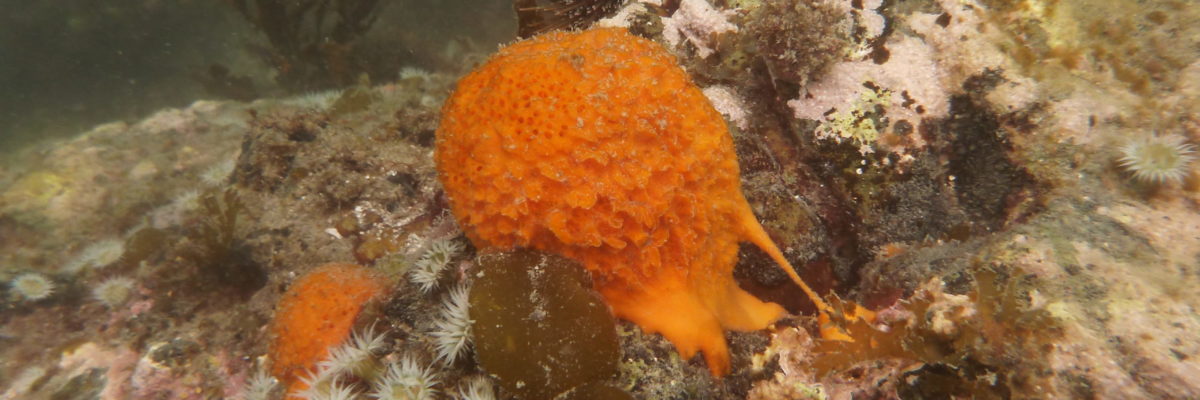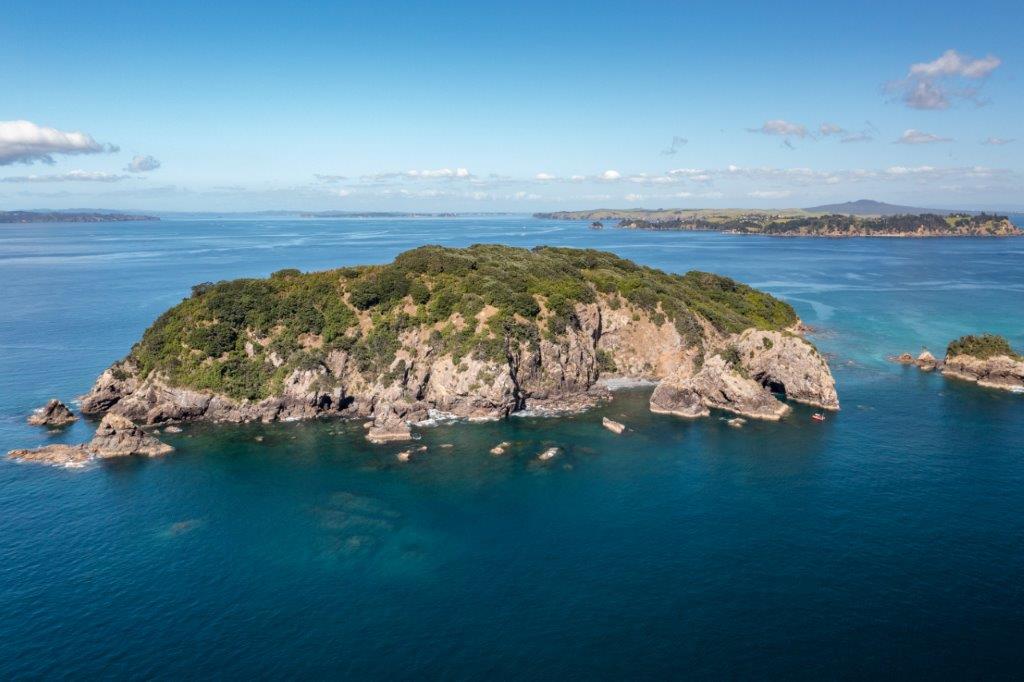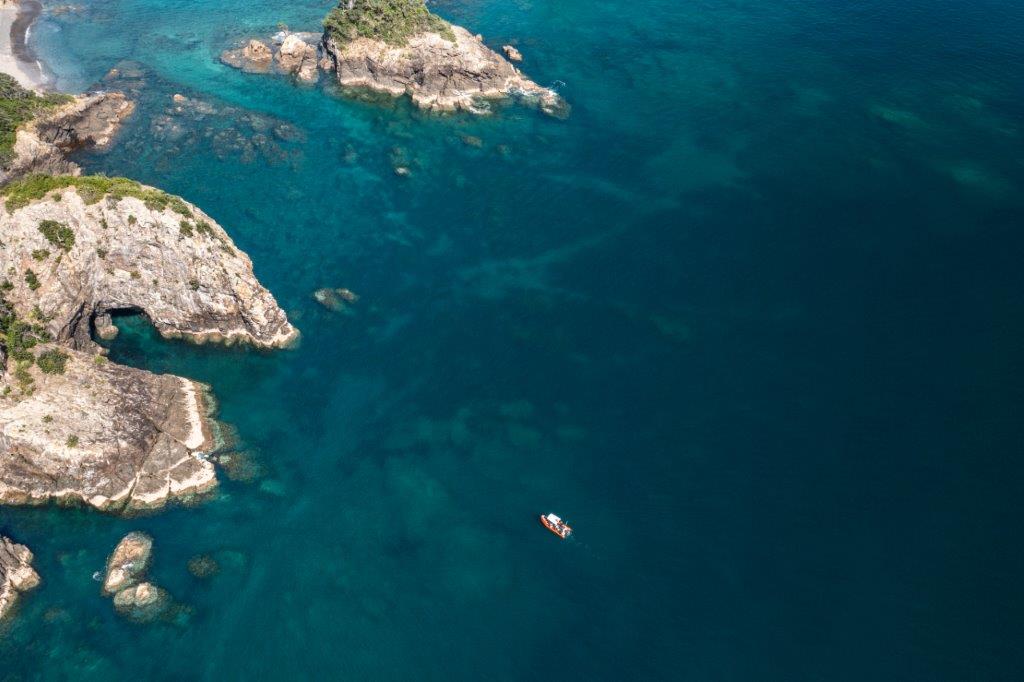The Noises hold a very special interest for seabird lovers. Being home to at least…

Where have all the sponges gone?
Normally so vibrant – I’m drawn to their brilliant colours and varied forms, beautiful underwater beacons of light. If you look closely, you’ll likely find little marine wonders living amongst them.
Four years ago, after two successive storms, the sponges had all but disappeared from around The Noises. They had been ripped off the rocks by a cyclone displaying a ferocity we’d never seen before. In the aftermath they became sad splashes of brilliance entangled amongst the torn-off seaweeds and deposited along the high tide mark, their colours fading by the day. Snorkelling after the storm revealed a newly ‘sepia-coloured’ world. One without contrast.
During that summer the water was warm and visibility poor, badly impacted by the constant northerly winds and swells. The rich underwater colours and textures of the pre-cyclone marine environment were being replaced by a monochrome coating of brown algae. Even the subtle colours of the subtidal pebbles had turned into fuzzy brown mounds. It was a deeply confronting sight that raised many questions, with few answers.
Two years ago, to our surprise and relief, the sponges were back! They were recovering, and we were again finding them in the special places they’d once been.
In the early part of last summer, the water was beautiful. It was clear and the sponges had fully returned to their former glory. We had no idea they could recover so fast and the gorgeous purple finger sponges seemed to be doing better than ever. Other species were recovering too. The mussels were returning – dense green and black shiny beds, clinging to the rocks and full of life. Happy days!
But by mid-January things changed as north-easterly weather conditions set in. The sediment stirred up by big swells made it difficult to snorkel or see what was going on beneath the surface and, in the brief windows of visibility, it was clear the algae of 2018 was returning. To make matters worse, a cyclone hit on 13 February 2022, the north-easterlies continued relentlessly, the water unnaturally warm, and it stayed that way.
A little later in summer, the underwater world had once again lost its vibrant colour. There were no bright spots of sponges to cut through the sediment and the ones still left were coated in algae. Areas of kelp had been torn off by the cyclone. The shiny new mussels were no longer there, with only some of the older, algae smothered ones remaining. The earlier relief I’d felt at the amazing underwater recovery disappeared along with the vibrant life.
The murky, persistent, northerly conditions have seen water temperatures sitting at over 20°C for more than five months around The Noises – they peaked at 24.5°C in mid-February. With unprecedented water temperatures like those, it would be short-sighted to imagine there won’t be consequences.
The weather continued to limit opportunities for snorkelling and by May the water temperature had dropped to about 18°C. When I finally got the chance to investigate, the visibility had improved and the cooling water had started to reduce the algae down to smaller patches, although it was still tenaciously coating the kina barrens. Sadly, it all looked like it did in May 2018.
Ever hopeful, I left one area I always enjoy until the end of my snorkel – it’s an area of battered, frayed, but still intact kelp forest at the southeast end of Ōtata. There, hidden amongst the kelp fronds I found baby sponge blobs – riotous little dots of colour just starting life! There were anemones, gastropods, triplefins, pipefish, and almost transparent tadpole-like juvenile fish – such a wealth of reasons for the joy and relief I felt! Here amongst the healthy forest, there was no evidence of unwanted algae.
That one hour in the water gave me cause for optimism. I saw for myself that having strong, resilient marine ecosystems may be the single most important thing that we can do to combat some of the effects of climate change. The kelp forests provide a refuge for life to continue to thrive or at least they provide a buffer and could help slow the impacts.
It’s troubling to think we just don’t know what future changes we’ll encounter. It’s only now, as they’re melting off the rocks, that we’re realising the sponges are in trouble. There are new and unwanted marine organisms arriving, but we don’t know what impact they’ll have. There are other consequences from five months of elevated water temperatures, yet we don’t fully understand what they are. There are far more questions than answers and it’s hard to know where to focus when there is no preview of what’s to come.
Had I known what I’d see at the end of this summer, I would have been more targeted with my haphazard underwater photos. I’d have ensured I captured the regenerating mussels and their exact location. I’d have recorded the areas of gorgeous sponges, and the state of the kelp forests, and I’d have recorded all the changes as the season progressed. My diary will be more detailed from now on.
I’m not the only one who will have to wait to see whether some of these things can recover over winter nor will I be the only one who will be on guard for different triggers in the marine environment in the future.



